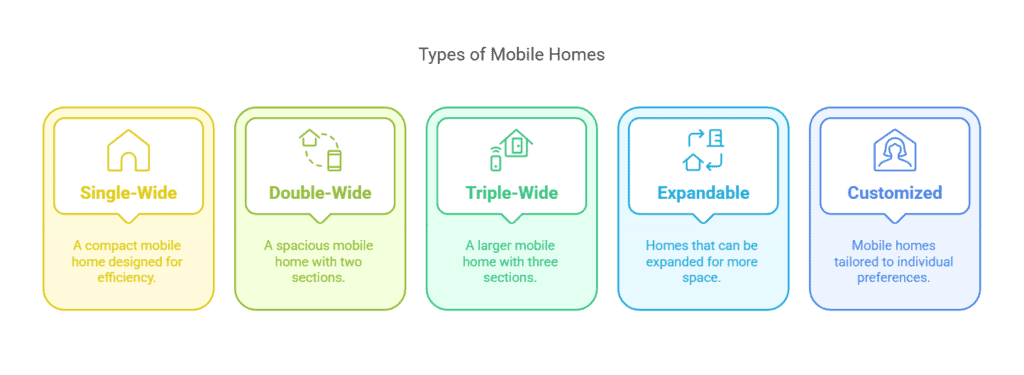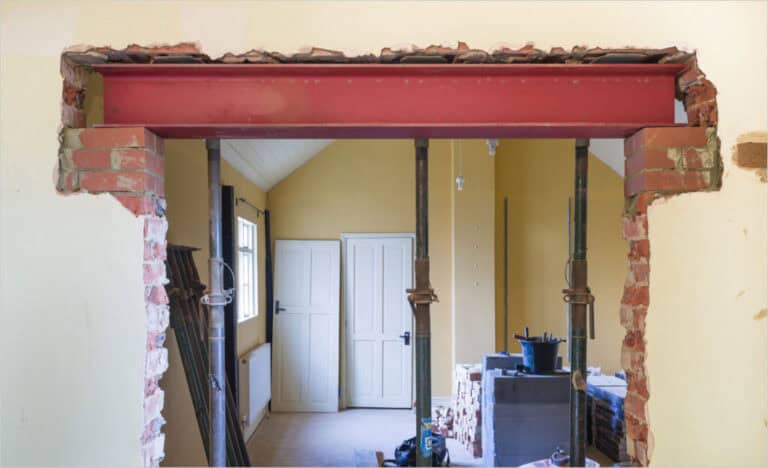Imagine: you can own a fully equipped home at a fraction of the traditional house price – this is not utopia, but the living freedom that more and more people are achieving through mobile homes. Are you curious about how these seemingly ordinary metal boxes have evolved from “temporary shelters” to part of the modern housing revolution?
You may have heard prejudices such as “mobile homes are tin houses” and “they can be blown away at any time”, but the truth is far more interesting than you think. This guide will take you to unveil its mystery: you will learn how different types of mobile homes can adapt to diverse needs, their real advantages and disadvantages, and even find out why some people would rather give up traditional single-family houses and choose this lifestyle.
What is a Mobile Home?
A mobile home, often prefabricated in a factory and then transported to the desired location for assembly, is a type of residence that can be easily relocated to various sites. Although they are usually fixed in one location for a long time, they can also be moved as needed. Mobile homes provide an affordable option for people with low-cost and flexible living needs, suitable for people with limited budgets or who need temporary housing.
Historical background of mobile home
- Mobile homes originated from trailer homes in the early 20th century. They were originally used as temporary living solutions and were widely used by the working class.
- With technological advances, mobile homes gradually evolved from trailers to more solid manufactured homes and began to meet building standards. In 1976, the United States enacted the Manufactured Housing Construction and Safety Standards Act, also known as the HUD Code, to establish standards for the manufactured housing industry.
- Modular homes then emerged, which are usually prefabricated in multiple modules in the factory. After assembly, they provide higher durability and beauty, becoming another popular choice.
Main features:
- Structural design: light steel structure or wood frame, easy to move.
- Materials: Metal or synthetic materials are commonly used on the exterior, with good waterproof and weather resistance.
- Space design: Although small in size, it is equipped with essential facilities such as a kitchen and bathroom.
- Mobility: Can be relocated as needed, suitable for needs with strong mobility.
- Energy efficiency: The design focuses on energy saving and reducing daily expenses.
- Cost-effectiveness: Compared with traditional houses, mobile homes have lower construction costs and are an affordable choice.
These characteristics make mobile homes a flexible and practical housing solution, especially for people who need low cost and flexibility.
Types of Mobile Homes
There are many types of mobile homes to meet different living needs and space requirements, mainly including the following:
Single-Wide Mobile Homes
Single-Wide houses are usually 14 to 18 feet wide, with a simple and economical structure, suitable for small families or people with limited budgets. Despite its limited space, it boasts basic living amenities including kitchens, bathrooms, and bedrooms. Its advantages are low cost and easy relocation, suitable for short-term or long-term living.
Double-Wide Mobile Homes
Double-Wide houses are composed of two units, with a width of usually between 20 and 30 feet, providing more living space and suitable for family use. They usually have more spacious living rooms, bedrooms and kitchens, and relocation is relatively complicated, but more comfortable than single-wide houses.
Triple-Wide Mobile Homes
Triple-Wide houses are composed of three modules with a width of more than 30 feet, suitable for large families or residents who need a large space. They are usually equipped with multiple bedrooms, large kitchens and multiple bathrooms. The structure is large and relocation is more difficult, but it provides the most spacious living space.
Other types of Mobile Homes
Expandable houses: can be expanded on the basic structure to add more space, suitable for families with growth needs.
Customized houses: customized according to personal needs, providing unique design or high-end decoration, suitable for residents who pursue personalization and comfort.
Each type of mobile home possesses unique characteristics. Selecting the one that aligns with your needs ensures that your requirements for space, budget, and lifestyle are adequately met.

How are Mobile Homes Built?
The construction of mobile homes is divided into the following stages:
Construction process
Mobile homes are prefabricated in factories. First, the chassis is built, usually with a steel or wooden frame. Subsequently, the walls, roof and floor are assembled in the factory to ensure speed and quality of construction.
Material and construction
Mobile homes are constructed using lightweight materials such as steel, wood, and synthetic composites. The exterior walls are generally made of metal or plastic panels, and the roof is made of metal or modified materials to ensure waterproof and weather resistance. The structural design meets building standards and ensures the house’s earthquake and wind resistance.
Moving and transportation
After the house is assembled, it is transported to the destination by trailer. During transportation, the house is divided into several parts and reassembled after arrival, connecting the necessary infrastructure and fixing the base to ensure stability.
Life Expectancy of Mobile Homes
The expected life of a mobile home is generally 30 to 55 years, depending on factors such as building materials, maintenance and environment. Although slightly shorter than traditional houses, proper maintenance can extend its service life.
How to extend the service life of mobile homes
- Regular inspection and maintenance: Check the structure, roof, and exterior walls of the house, and repair the damaged parts in time.
- Waterproofing: Waterproofing the roof and walls is essential to prevent water infiltration.
- Infrastructure maintenance: Check the power and water supply systems and replace aging parts regularly.
- Avoid frequent relocation: Try to avoid frequent relocation to reduce structural damage.
- Maintain the external environment: Clean the surrounding environment and avoid plants from contacting the exterior walls or roof of the house.
By implementing these measures, the lifespan of the mobile home can be effectively prolonged, and favorable living conditions can be sustained.
Advantages of Mobile Homes
Affordable housing options: Mobile homes are usually cheaper than traditional homes and are suitable for people with limited budgets, providing a more affordable option for first-time homebuyers, retirees and small families.
Relocation: Mobile homes can be relocated as needed, providing flexibility, especially for people who need temporary homes or move frequently.
Customization options in design: Many manufacturers offer customization options, allowing buyers to choose the layout and decoration style of the house according to their needs, enhancing the personalized experience.
Quick construction and move-in: Because mobile homes are prefabricated in the factory, the construction time is short, and they can be quickly installed after being transported to the destination, reducing waiting time.
High energy efficiency and reduced daily expenses: Modern mobile homes focus on energy-saving design and use efficient materials and equipment to help reduce energy consumption and daily expenses.

Challenges and Considerations of Mobile Homes
Depreciation issues: Compared with traditional houses, mobile homes usually depreciate faster, especially if they are not well maintained or moved frequently.
Financing difficulty: It is more difficult to obtain loans for mobile homes, and interest rates may be higher. It is crucial to familiarize oneself with the pertinent loan options and their respective conditions.
Zoning and land use regulations: The installation location may be restricted by law. Certain areas may impose prohibitions or restrictions on the installation of mobile homes. You need to understand local regulations in advance.
Maintenance requirements: Mobile homes require regular inspection and maintenance, including maintenance of roofs, exterior walls and infrastructure. Ignoring these details may cause damage.
Space limitations: Mobile homes are usually small in size and require flexible planning to maximize utilization. They may not accommodate large families or individuals with extensive space needs.
Mobile Homes vs. Modular Homes vs. Trailers vs. RV vs. Tiny House
| Feature | Mobile Homes | Modular Homes | Trailers | RVs | Tiny Houses |
| Structure | Steel or wood frame | Assembled from modules | Lightweight, movable | On wheels | Small, often wood construction |
| Size | Small to large (Single-Wide, Double-Wide, Triple-Wide) | Similar to traditional homes | Small, for short stays | Moderate, for 1-6 people | Typically 100-400 sq ft |
| Mobility | Can be moved, usually fixed | Fixed location | Highly mobile | Fully movable | Movable, suited for long-term stays |
| Materials | Metal, wood, synthetic materials | Traditional building materials | Metal, plastic | Lightweight materials | Wood, metal, recycled materials |
| Installation Speed | Fast (days to weeks) | Faster than traditional homes | Simple and quick | Quick setup, travel-ready | Simple setup, space limited |
| Customization | Customizable interiors/layouts | Highly customizable | Few customization options | Various interior options | Highly customizable |
| Value Retention | Depreciates quickly | Retains value, like traditional homes | Depreciates quickly | Depreciates fast | Depreciates but unique appeal |
| Comfort | Basic comfort, small spaces | Similar to traditional homes | Short-term comfort | Basic amenities, for travel | Compact, efficient, minimalist |
| Energy Efficiency | Energy efficient | Similar to traditional homes | Lower efficiency | Varies by model | Highly energy efficient |
Related Reading: Mobile Homes vs. Modular Homes
Who Should Consider a Mobile Home?
- First-time homebuyers: Mobile homes are relatively cheap and are ideal for first-time homebuyers.
- Retirees: Mobile homes provide retirees with flexible living options that are affordable and easy to maintain.
- Families looking for flexible living space: Mobile homes provide greater convenience for families who need to move frequently or pursue flexible living styles.
Suitable living environment
- Urban suburbs: Suburban land prices are relatively low, which is suitable for families with limited budgets.
- Countryside: In the countryside, mobile homes can provide more space and are suitable for those who pursue a quiet life.
Mobile homes are an ideal choice for families with limited budgets, who need flexible living or who seek more space.
Common Misconceptions about Mobile Homes
Myth 1: Mobile homes are unsafe
- Modern mobile homes follow strict building standards, especially after 1976, and their wind and earthquake resistance have been greatly improved to meet safety requirements.
Myth 2: Mobile homes will not appreciate in value
- Although mobile homes may depreciate, if properly maintained, homes located in high-demand areas may still appreciate in value.
Myth 3: Mobile homes cannot be financed
- Many financial institutions offer specialized mobile home loan products, although the loan process may be more complicated.
Myth 4: Mobile homes are not suitable for long-term living
- The design and construction quality of modern mobile homes has greatly improved, making them suitable for long-term living, especially for families with less space and maintenance.
An alternative solution to mobile homes: modular construction
Mobile homes provide an affordable, flexible and comfortable living option for many families, suitable for first-time homebuyers, retirees and families who need flexible living space. Despite some misconceptions, modern mobile homes have greatly improved safety and comfort, making them suitable for long-term living.
If you are looking for a higher quality living solution with long-term investment value, we recommend you consider Modular Construction. Modular homes offer greater durability, more space and more customization options, making them an ideal long-term choice. Our modular homes can meet a variety of needs and are a reliable solution worth investing in.

